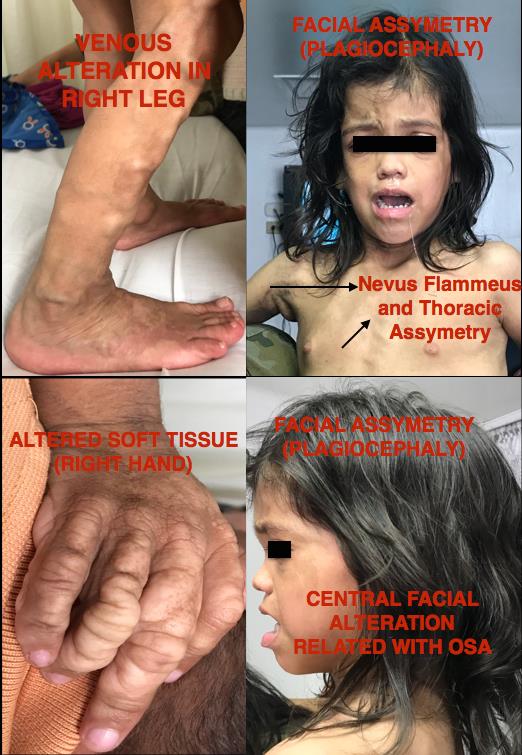NM-310
Klippel Trenaunay Weber syndrome: How to face it?. Tips for the anesthesiologist
Amezquita trujillo A, Garzon J, Cabrera hernandez J
HOSPITAL DE LA MISERICORDIA, BOGOTA, Bogota, Colombia
Female patient of 2 years with a history of Klippel Trenaunay Weber syndrome (KTWS), craniosynostosis, neurodevelopmental delay and severe OSA, scheduled for adenotonsillectomy. At the physical examination with plagiocephaly, micrognathia, acceptable oral opening, prognathism, kyphoscoliosis, nevus flammeus in the neck, thorax and upper right limb; digital deformity in hands, venous dilatation in right lower limb and asymmetry of lower limbs, DIVA score 6. Echocardiogram with asymmetric septal hypertrophy, pulmonary pressure and normal ventricular function. In surgery: basic monitoring, inhalation induction with sevoflorane for spontaneous ventilation (difficult airway and high risk of obstruction of the airway), canalization with peripheral access 24G; ketamine is administered at 0.5 mg / kg; lidocaine jelly through the left nostril by nasotracheal tube nº3 is administered 100% O2; by right nostril and fiberoptic bronchoscope, nasotracheal intubation with tube 4. Maintenance with sevoflorane and remifentanil at 0.5 mcg / kg / min, analgesia and antiemetics with: dipyrone 600 mg, paracetamol 300 mg, dexamethasone 1.5 mg and metoclopramide 3 mg . Procedure without complications. Extubation and observation for 24 hours in the intermediate care unit (for SAHOS) without complications and discharge.
KTWS is a congenital entity associated with bone and soft tissue hypertrophy, venous or lymphatic anomalies and cutaneous capillaries (nevus flammeus). Incidence of 1/27500 births, related to mutations of gene that codes for protein guanosine 5 triphosphatase, key regulator in vascular embryonic development. The clasic triad (hemangioma, soft tissue hypertrophy and over bone growth, varicose veins of an extremity) is characteristic of this entity.
Anesthetic considerations:
-Ecocardiographic evaluation for risk of high-output heart failure.
-Discard vascular malformations for bleeding risk, avoid hypertension peaks.
-Difficulty airway approaching due to craniofacial and thoracic malformations.
-For central venous access, malformation of subclavian and jugular veins should be ruled out.
SKTW is a rare entity, related to vascular, osseous and soft tissues alterations that impose anesthetic challenges; such as difficult airway, difficult peripheral and central venous access, elevated risk of bleeding. This case of a patient with OSA, craniosynostosis as comorbidities, imposed an additional challenge for airway management (fiberoptic intubation, maintenance of spontaneus ventilation), intravenous access and peri-operative care, with good results and no complications.
-Wang, S. et al. Diagnosis and management of the venous malformations of Klippel-Trénaunay syndrome. J Vasc Surg: Venous and Lym Dis 2017;5:587-95.
-Volz, K. et al. Klippel-Trénaunay Syndrome Need for Careful Clinical Classification. J Ultrasound Med 2016; 35:e5–e13.
-Hammer, M. et al. Thoracic Manifestations of Klippel-Trenaunay Syndrome.J Thorac Imaging 2017;32:W5–W6.
Top












